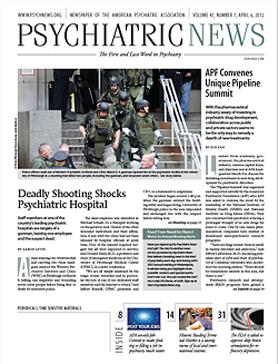Long-term use of stimulants by children with attention-deficit/hyperactivity disorder (ADHD) does not appear to increase risk of hypertension, according to a 10-year follow-up study.
The report, “Blood Pressure and Heart Rate Over 10 Years in the Multimodal Treatment Study of Children With ADHD,” was one of two in the February American Journal of Psychiatry (AJP) that offer reassuring evidence about the effect of stimulant medications on cardiovascular health—though both reports also carry caveats to which clinicians should be alert and indicate the need for further research.
A second study on use of methylphenidate in adults found no association between use of the drug and stroke or heart attack, but did find an association with sudden death/ventricular arrhythmia; however, that association was not dose related and thus may not be causal (see
Stimulants & Cardiovascular Safety: Risk-Benefit Issues Get Clearer). (A third study in the same issue of
AJP reported data on changing rates of use of stimulants among different age groups.)
But the analysis of long-term stimulant use in children is likely to be of most interest to clinicians and parents concerned about the cumulative effect on cardiovascular health of medications known to increase heart rate and blood pressure in the acute phase of treatment.
“The main purpose of the study was to test whether chronic, long-term use of stimulant medication translated to an increased rate of blood pressure in the hypertensive or prehypertensive range, and it doesn’t seem to be the case,” lead author Benedetto Vitiello, M.D., told Psychiatric News. “So our results are generally supportive of the long-term use of these medications.”
He is chief of the Child and Adolescent Treatment and Preventive Intervention Research Branch of the National Institute of Mental Health.
Importantly, Vitiello and colleagues found that greater cumulative stimulant exposure was associated with a higher heart rate at years 3 and 8. “There was a detectable effect on heart rate that persists after years of treatment,” Vitiello said. “So these medications should be used with caution in children with cardiovascular conditions, because the body does not fully habituate to the stimulating effect on the heart event after years of treatment.”
Data for the analysis were drawn from the Multimodal Treatment Study, a publicly funded multisite randomized, controlled trial that compared the effectiveness of different treatment interventions for children with ADHD. In the study, 579 children aged 7 to 9 were randomly assigned to 14 months of medication treatment, behavioral therapy, the combination of the two, or usual community treatment.
After the 14-month trial, all patients received naturalistic community treatment—in which they may have received any of the treatments—and were assessed at specified time points (2, 3, 6, 8, and 10 years after randomization). At year 2, a normative control group of children who had never received stimulant medication was included in the analysis.
Two analyses were undertaken: the first analysis looked at blood pressure and heart rate based on intent to treat—that is, based on the group into which the children had been randomized. A second analysis looked at associations between cumulative stimulant exposure over the follow-up period of community treatment and blood pressure or heart rate at different periods.
Vitiello and colleagues found no treatment effect on either systolic or diastolic blood pressure. Children who were treated with stimulants had a higher heart rate than those who were treated with behavioral therapy alone or those who received usual community treatment at the end of the 14-month trial, but not thereafter.
The authors indicated, however, that further research is needed. “The clinical implications of persistent adrenergic stimulation, especially for individuals with underlying heart abnormalities, are unclear and cannot be elucidated from these data, but a graded relationship, independent of systolic blood pressure, between increasing resting heart rate and mortality is well documented epidemiologically in adults,” Vitiello and colleagues wrote. “Thus, the adrenergic effect of stimulants cannot be dismissed and should constitute reason for concern and further evaluation of the long-term safety of these medications.”
Results from the study are particularly important in light of the rising use of stimulant medications. In a separate study in the same issue of AJP, Vitiello and Samuel Zuvekas, Ph.D., examined the utilization of stimulant medications for the treatment of ADHD in U.S. children during the period 1996 to 2008. They found that pediatric stimulant use has been slowly but steadily increasing since 1996, primarily as a result of greater use in adolescents.
But importantly, they found that use in preschoolers remains low and has declined over time. Important variations related to racial/ethnic background and geographic region persist, thus indicating a substantial heterogeneity in the approach to the treatment of ADHD in U.S. communities.
Child psychiatrist and APA Treasurer David Fassler, M.D., said results of the study on cardiovascular health are generally reassuring while also signaling to clinicians the need to be alert to effects of long-term use in some children. “Most young people tolerate stimulant medication with minimal side effects,” Fassler said. “However, the results of this study underscore the importance of weighing the potential risks and benefits of treatment for each individual child. They also suggest that efforts should be made to minimize cumulative stimulant exposure, where possible.”
He added, “I agree with the authors’ conclusion that the clinical implications of their findings deserve further investigation, particularly with respect to patients with preexisting cardiac abnormalities.”
In an accompanying editorial, child psychiatrist Christopher Kratochvil, M.D., drew attention to several limitations in the heart-rate and blood-pressure study. These include the exclusion of children with identified cardiovascular disease, suboptimal lack of standardization of blood pressure and pulse measurements across sites, attrition over time, and failure to confirm abnormal blood pressure values over three separate assessments, as would be required to make a diagnosis of prehypertension or hypertension.
But Kratochvil said the Vitiello study, as well as the analysis of effects of methylphenidate in adults, provide a widening insight into the effect of stimulants on cardiovascular health that is broadly supportive of their use.
“While gaps persist in the methodical and comprehensive assessments of the safety of ADHD medications,” Kratochvil wrote, “these studies add valuable information to our already large repository of safety and efficacy data of ADHD pharmacotherapies and better inform the risk-benefit analysis of their use.”


